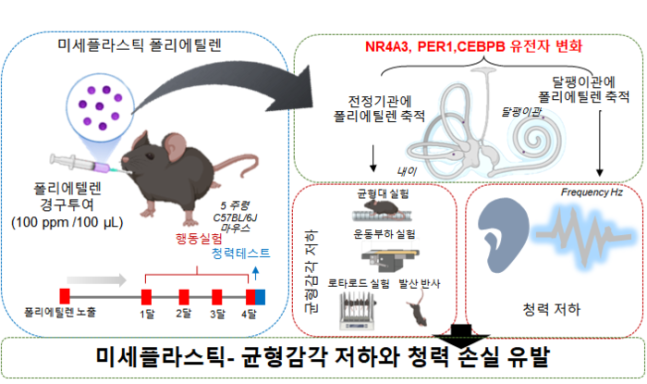Joint research team from Nuclear Medicine Institute, Seoul National University, and Chung-Ang University announced
Experimental mice consuming polyethylene experience hearing and balance impairment,

,
,
,

Kim Jin-soo, Ph.D. from the Korean Nuclear Medicine Institute (left) and Park Min-hyun, professor at Seoul National University’s College of Medicine. Provided by the Korean Nuclear Medicine Institute,
,
, ‘A Korean research team has discovered for the first time in the world that ‘microplastics’ scattered across the oceans and soil worldwide have a detrimental effect on the auditory health of living organisms. Microplastics, which refer to plastics smaller than 5mm, were found to cause issues not only in hearing but also in balance sensation.’,
,
, ‘A joint research team composed of Kim Jin-soo, a Ph.D. from the Korean Nuclear Medicine Institute’s Radiology Research Institute, and Park Min-hyun, a professor at Seoul National University College of Medicine, announced on the 24th that microplastics can damage the ‘labyrinth’ in the ear, leading to hearing loss and impaired balance sensation. The ear is divided into outer ear, middle ear, and inner ear depending on depth. The research results were published in the international journal ‘Journal of Hazardous Materials.’,
,
, ‘The research team fragmented ‘polyethylene,’ a plastic commonly used in various disposable items including containers and packaging films, into microplastic size and fed it to experimental mice at a daily dose of 10 micrograms (㎍·100 millionths of a gram) for 4 months. They discovered that polyethylene accumulated 0.144㎍ in the inner ear, affecting the ‘cochlea,’ responsible for hearing, and the ‘vestibular organs,’ responsible for balance sensation.’,
,
, ‘When the hearing test was conducted, the control group mice that did not consume polyethylene responded at 31.7 decibels (㏈), while the mice that consumed polyethylene responded at 54㏈. In humans, 50-60㏈ represents noise loud enough to increase respiration and heart rate, leading to potential sleep disorders. Mice that consumed polyethylene had significantly impaired hearing, needing much louder sounds to be barely audible compared to mice that did not consume polyethylene.’,
,
, ‘To measure balance sensation, the research team had the control group mice and the polyethylene-consuming mice run on a treadmill, revealing differences.’,
,
, ‘The control group mice were able to maintain balance and exercise for an average of 515.7 seconds, while the polyethylene-consuming mice could only maintain balance for an average of 322.1 seconds, about 40% shorter. When the polyethylene-consuming mice encountered situations where their bodies swayed during running, they struggled to recover balance and fell off the treadmill.’,
,
, ‘The research team confirmed that mice consuming polyethylene exhibited a high expression of genes related to cell death and inflammation, leading to damage in the cochlea and vestibular organs.’,
,
, ‘The researchers stated, “Through this study, the harmful effects of microplastics have once again been proven” and expressed their intention to conduct follow-up studies related to the inner ear to raise awareness about the indiscriminate use of plastics.’

